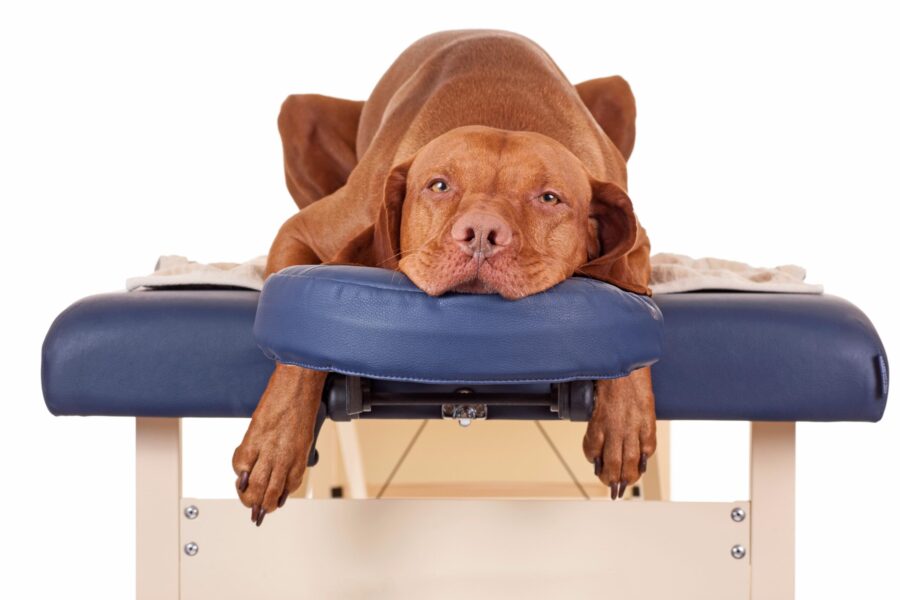
Check out our latest products
For many dog owners, the idea of chiropractic care for animals sounds either surprising or downright strange. Isn’t chiropractic something for people with bad backs? What does it have to do with dogs? As it turns out, a lot.
Animal chiropractic is a growing field that focuses on one critical principle: the connection between the spine and the nervous system. When that connection is free and functional, your dog’s body works better. When it’s restricted, the result can be pain, stiffness, behavioral changes, and even organ dysfunction.
The beauty of chiropractic lies in its simplicity. It doesn’t treat specific diseases or prescribe medication. Instead, it works with your dog’s own innate intelligence, the body’s built-in ability to heal and regulate itself. When the spine is properly aligned, that natural healing potential is unleashed.
Understanding the Nervous System-Spine Relationship
To understand how animal chiropractic works, you first need to understand how the nervous system functions. The nervous system is the master control system of the body. It sends messages between the brain and every organ, gland, muscle, and tissue. Whether your dog is wagging their tail, digesting breakfast, fighting off an infection, or reacting to a sound, it all happens through the nervous system.
The spine houses and protects the spinal cord, which is like the main communication highway connecting the brain to the rest of the body. But the spine is more than a shield—it’s a moving, dynamic structure. Each vertebra is connected by joints, supported by muscles, and wrapped in connective tissue. When one of those vertebrae becomes restricted in movement or misaligned (a condition called a vertebral subluxation), it can irritate nearby nerves or interfere with signal transmission.
This nerve interference can lead to a wide variety of symptoms—some obvious, like limping or stiffness, and some subtle, like lethargy, frequent infections, behavioral changes, or poor digestion. Chiropractic care addresses these problems not by treating symptoms directly, but by correcting the structural imbalances that cause them.
What Happens During an Animal Chiropractic Session?
Certified animal chiropractors begin with a detailed health history and a hands-on examination of your dog’s posture, gait, spinal alignment, and muscle tone. They may ask about behavioral changes, appetite, or even how your dog prefers to sit or sleep—because all of these can offer clues about what’s happening in the spine.
Next comes the palpation exam. The chiropractor will gently feel along the spine and joints, assessing restricted movement, muscle spasms, heat, swelling, or misalignment. This step is precise and highly refined—animal chiropractors are trained to detect subtle shifts that aren’t visible to the untrained eye.
If a subluxation is detected, the chiropractor delivers a gentle, specific adjustment. This is a rapid but controlled movement applied by hand to a joint that is not moving correctly. The goal is to restore normal motion, reduce tension, and remove interference from the nervous system.
Contrary to popular belief, adjustments are not forceful, and they’re nothing like the dramatic “cracking” you may have seen in human chiropractic videos. In fact, most dogs tolerate the adjustment well and often respond with a stretch, shake, or visible relaxation afterward. Some dogs even fall asleep.
Is It Safe?
Yes, when performed by a certified professional, animal chiropractic is very safe. Chiropractors and veterinarians who pursue post-graduate certification in animal chiropractic undergo hundreds of hours of specialized education, including anatomy, neurology, biomechanics, and hands-on clinical skills. Programs like those recognized by the American Veterinary Chiropractic Association (AVCA) require rigorous training and testing.
That said, chiropractic should never be performed by someone without proper credentials. Dog anatomy is not the same as human anatomy, and improper techniques can cause harm. Always ask to see proof of certification, and make sure your animal chiropractor is legally permitted to practice in your state or province.
What Can Chiropractic Help With?
Because the nervous system is involved in virtually every function of the body, chiropractic can have wide-reaching benefits. These may include:
- Improved mobility and flexibility
- Relief from stiffness, limping, or lameness
- Enhanced performance in working and sport dogs
- Faster recovery from injuries or surgeries
- Reduced inflammation and joint stress
- Better digestion and elimination
- Increased energy and engagement
- Support for aging dogs dealing with arthritis or weakness
- Reduction in anxiety and mood-related behaviors
But chiropractic doesn’t “treat” these conditions in the way traditional medicine does. It simply removes interference so that the body can correct its own dysfunctions. For example, if a misaligned vertebra is affecting the nerve that supplies the hind leg, restoring that alignment can allow the nerve to resume normal function, and the dog may stop limping.
Chiropractic is particularly valuable for:
- Performance Dogs: Agility, herding, flyball, and dock-diving dogs place significant demands on their bodies. Routine chiropractic care can improve coordination, prevent injuries, and support recovery.
- Senior Dogs: Older dogs often experience stiffness, muscle loss, and balance issues. Adjustments can improve comfort and slow the physical decline associated with aging.
- Puppies: Rapid growth, awkward play, and birth trauma can all contribute to early misalignments. Starting chiropractic care early can help set a foundation for balanced development.
- Post-Surgical Dogs: Dogs recovering from orthopedic surgery often develop compensatory patterns. Chiropractic care can help them regain symmetry and prevent overuse of the opposite limb.
How Often Should My Dog Get Adjusted?
There’s no one-size-fits-all answer. Frequency depends on your dog’s age, activity level, health status, and goals. An agility dog might benefit from weekly or biweekly adjustments during competition season. A senior pet may do well with monthly care to manage arthritis. For many family pets, a schedule of every 4–6 weeks works well as maintenance.
After an initial exam and adjustment, your chiropractor will recommend a care plan based on your dog’s specific needs. Just like with dental cleanings or grooming, consistency is key to getting the full benefit.
What’s the Difference Between Chiropractic and Other Modalities?
Chiropractic care is sometimes confused with massage, physical therapy, or acupuncture. While all of these are valuable, they each serve different functions:
- Massage targets soft tissues to relieve tension and improve circulation.
- Physical therapy focuses on rehabilitating injured muscles and joints through exercises and modalities.
- Acupuncture stimulates specific points on the body to influence energy flow and nerve function.
- Chiropractic corrects joint restrictions to restore normal spinal function and nerve flow.
Often, the best outcomes occur when these modalities are used together in an integrative care plan. Chiropractic is not meant to replace your veterinarian, but to complement their care by addressing structural imbalances that can affect recovery and performance.
What Results Can I Expect?
Results can be immediate, cumulative, or subtle. Some dogs show improvement right after their first adjustment—moving more freely, jumping up with ease, or playing with renewed enthusiasm. Others need several sessions before significant change is noticeable, especially if the problem has been long-standing.
Just as importantly, chiropractic helps prevent problems before they start. Many owners report fewer injuries, fewer vet visits, and better overall wellness when their dog receives regular adjustments.
And then there’s the intangible: the lightness in your dog’s step, the extra tail wags, the way they stretch and breathe more easily. When the body is in balance, your dog simply feels better—and it shows.
The Takeaway:
Animal chiropractic is not a trend—it’s a science-based, hands-on way to help your dog live a more comfortable, agile, and balanced life. Whether your dog is a working athlete or a beloved couch companion, chiropractic care supports the nervous system that runs it all. When that system is clear, your dog has the best chance to heal, move, and thrive—naturally.
Post Views: 22
Dr. Bill Ormston graduated from Iowa State University College of Veterinary Medicine in 1988. After attending Options For Animals in 1998 he received certification from the AVCA and began using chiropractic to treat his animal patients. Jubilee Animal Health is a mobile mixed animal practice in the Dallas Metroplex area where he cares for pets and horses using mostly alternative methods. He is one of the founding instructors of the post graduate course in Animal Chiropractic at Parker Chiropractic College in Dallas. Dr.O has lectured both nationally and internationally on Animal Chiropractic and biomechanics and gait analysis in the quadruped. He has written booklets on chiropractic care in the dog and horse and a book about blending traditional and alternative care in pets.


![[PETHROOM] Cat Nail Clipper Trimmer for Indoor Cats with Circular Cut Hole (2mm) | Premium Sturdy Stainless Steel Blade Cat Claw | Safe, Easy, Accurate, Quiet & Fast | Avoid Overcutting](https://m.media-amazon.com/images/I/6156hi88deL._AC_SL1298_.jpg)
![[PETHROOM] Professional Eye Comb for Pets | Stainless Steel Tear Stain Remover for Cats & Dogs | Gentle Round-Head Grooming Tool | Compact & Portable for Eye Gunk Removal](https://m.media-amazon.com/images/I/71+W758uwXL._SL1500_.jpg)
![[petora] BRUSH ON ME Gentle Facial & Eye Comb for Dogs & Cats | Smooth & Stress-Free Tear Stain Remover | Fine-Tooth Grooming Tool with Rounded Tips | Comfortable Grip for Daily Pet Grooming](https://m.media-amazon.com/images/I/81hzVmjgV1L._SL1500_.jpg)








